#The Scribe and the Sphinx
Explore tagged Tumblr posts
Text
Just for fun today, let's share something REALLY old (2014 or so.) If you've been following along reading my chapters, perhaps you'll be interested in seeing how I've improved! This is adult HISTORICAL fantasy, written when I had access to a college library and could get out the big academic books about this time period! Fun times but I've forgotten all my notes and would have to start over with research to rewrite it. So it will probably never happen!
The Scribe and the Sphinx
Chapter 1
Sudan, 340 AD.
It is so strange and unpleasant to be leaving.
My hand traces the engravings on the temple walls before me. My fingers dip into crevasses that mark a lion's roaring head, the head of a god. The temple is quiet around me, dust hanging in the sunbeams that pierce down through the high windows. I'll never see these walls again.
My objections to going home are not sensible, although I claim to be a sensible man. My colleagues satisfied themselves that all texts were found months ago and stopped coming. Most took the camel trains home to Bedewi, where there is a newer Lion Temple, still maintained and attended. But the reliefs in front of me have a power lacked by those decorating the temple at Bedewi. Apedemak's hand cuts down a fleeing enemy, his mouth open in a roar, his mane falling down over human shoulders. Lions cavort at his feet.
There is a noise, out of place and jarring in the silence: the lowing of cows and some animal clattering on the mud-brick road outside. I ignore it. "Great god, great of roaring, strong of arm," I mutter to myself, remembering hymns I have copied. I'll miss it here, among the images of the gods.
Dust tickles my nose, I sneeze, and the moment is broken. I turn away to survey the rest of the temple. A century ago, Aborepi was the jewel of upper Kush, and this small temple would have been richly attended. But now, as we all trickle away from the southern reaches of the nation, it lies untended. The kings and kandakes whose images bow before the gods on these walls are long dead. Most Kushites would not even know who they had been.
I've made records of these carvings, and their names, and collected the writings of the scribes of those times. Even if this part of Kush falls to the barbarian kingdoms to the south, Aborepi won't be forgotten. Not if I have anything to say about it.
I walk through the temple, my sandals loud against the stone floor. A small pile of broken tablets and torn parchments lies in a corner near my bags. This time, I have nothing to add to it. The pile looks tiny and insignificant beneath the carvings of the gods, but I've no regrets for wasting my morning finding these bits and pieces. These are the oldest documents I've found around Aborepi, jammed in corners and edges, long forgotten by the few people who still travel to worship here the way our ancestors did. The rest of the tablets and scrolls I've collected are already back at Tolkte, the nearest inhabited city.
I load this last armful and hoist the bag onto my back. With a last look at the Lion Temple, and a bow to my god, I turn to leave.
It is a short walk out. Every inch of the temple is carved with pictures that I've seen a hundred times before. I ignore them, but a single column near the door catches my eye as I pass. The sunbeam that comes in the window high above casts the relief on it into shadow and light. On the sandstone pillar, a lion with a woman's head and uplifted wings rends a fleeing antelope with her right front paw. On the sphinx's back, a man with a lion's head and the crown of a god stabs down with his spear and slays the antelope's mate. I've never seen a wild lion or a sphinx, and I wonder if I ever did whether Apedemak's hand would truly guide it, as legends say, or if it would swallow me whole and leave my scrolls scattered through the brush.
The front gate stands like a window against the sky, the door long rotted away. The sun is still low in the sky; I left Tolkte this morning to come here before it had properly risen in order to avoid the heat. As I walk through the doorway, for a moment the light strikes me just so that I can see nothing but the blood vessels of my eye against that red glare. When my vision clears, the twin lion statues outside that guard the door come into view. Between them stands a man that I do not know.
I freeze on the threshold as the sense of relaxation the quiet temple gave me flees like water through a drain. The stranger smiles at me, big and bold and unapologetic. His skin is nearly as black as my own, and his teeth are a white slash across his face.
I'm a three hour camel ride from the nearest habitation. He should not be here.
"Lord Scribe?" the stranger says, his white teeth still bared.
I back a step sideways from the door, putting the wall at my back. "What are you doing here?"
He doesn't budge from the doorway, nor dim the intensity of his smile. "I've come from Tolkte to speak with you. The temple told me that you were headed this way." He wears a sturdy kilt, and he is less hungry-looking than many of the people still at Tolkte, but the edge to his face speaks of desperation, and he wears no wig at all over his shaven head. He looks a few years older than me, perhaps twenty-five. If I had seen him at Tolkte, I'd have thought him a beggar, but for the sword on his belt.
I take another step to the side. My only knife is at the bottom of my bag, but I wish it were in my hand. "And you couldn't wait to seek me when I returned this afternoon?"
He shrugs. "Ah. They told me also that you were leaving Tolkte soon, and I thought I should seize the opportunity, Lord Scribe."
I'm not leaving for days. Someone who has spoken with the temple should know that. "I am no lord."
"You're a priest, are you not? Closer to the gods than I? A servant to the people? I'm in need of a servant of the people."
I am a priest, yes, sworn to Apedemak and Thoth, but I'll not tell that to a man who accosts me in the wilderness. Besides, words have called to me more of late than service to anybody. "If you seek a blessing or aid with a hymn, the active temple is back at Tolkte."
His smile broadens, and he shakes his head. "No, no. I seek you. You are Dekeli? You're the collector of words, are you not? The one who listens to the stories of the herders and villagers and the Noba?"
I shift uncomfortably and take another step, since he hasn't stopped me. The edge of the building is not far away. The scrublands beyond are lined with nothing but small acacia trees and the stubble of what was once grass. The great enclosure to the north looms, far larger and more complex than this small temple, but there is nowhere within to hide from a man mad enough to pursue me from Tolkte. "I don't speak with the Noba."
"You trade for tablets and scrolls," he insists, although the Noba have neither.
This man hardly looks like he could inscribe his name. "You have a scroll?"
He shakes his head. "You do. One I will trade very well for."
Suddenly, the pack on my back feels vulnerable, and the wall behind me protective. "I'm not interested, and I don't have any of my scrolls or tablets with me."
He bobs his head at me. "Then I'll come back with you to Tolkte, and I will buy it there. Shall we walk to our camels?" He gestures behind him with a sweep of a well-muscled arm towards the huge, mostly full hafir that long-dead Kushites dug east of the Lion Temple and the great enclosure to the north.
My camel, Wdkid, is tied up near the water. Another camel, small and weedy, now stands beside him. A brown cow lounges between them, its ribs sharp, its belly sunken. The rest of its herd loiters farther down canal, their tails swishing the warm morning air.
I make a break for the camels, but the man jogs easily alongside me.
"Shall we ride back together?" he asks me.
Wdkid ignores me as I approach, his head glued to the water. I gasp, out of breath, "If you want scrolls or hymns written down, you ought to talk to my colleagues that are staying on in Tolkte. They have many skilled scribes there."
He shakes his head. "I want only a specific one. I'll pay you. I know that you have it. You hired my friend to help when you first came here. He saw it."
I start and grab for Wdkid's lead. I know the man he must be speaking of. Early on, before I had learned the way to Aborepi by heart, I hired local guides to bring me here and help carry back the things that we found. I've hired few people to assist me since, not trusting them to handle delicate things, and only one that could read well enough to identify a document to someone else. But I dismissed that man for attempting to steal from me, for tucking a tablet in his bags like a thief and lying that he had ever found it. I trust no one who references him.
I fling my pack up onto the simple stick frame of Wdkid's saddle and yank his lead free from the stake securing it. When I pull his head away from the hafir, he yawns at me and shakes his neck, but then he drops to his knobby, callused knees and suffers to let me mount. As he lurches back to his feet, I stare down at the man. He stands with his hands on his hips, looking up at me with lifted eyebrows.
Up on the camel, some four feet above the man's head, I feel secure. My voice sharpens. "I have collected those artifacts to preserve the history of this place. I will not sell one for any item you could possess!"
The man's lips press tightly together. I pull on Wdkid's reins, too hard, and turn him southeast towards Tolkte. I drive the camel harder than I have ever done and do not look back to see if the man is following me.
***
The city of Tolkte, as I arrive in the early afternoon, is surrounded by camels and a handful of horses. Wdkid lengthens his stride at the sight of them, jouncing me about on his back and rattling the bags of tablets that hang off his sides. I thump the hump beneath me, and he slows back to a brisk trot.
The day is warm now that the sun is high, but there are people and camels all around the city, swarming like an army of termites around a rain-ruined mound. I've not seen so many since the great trains of traders that passed between kingdoms stopped coming, nearly three years ago. It's puzzling activity, frantic but clearly purposeful. After my encounter with the strange man, it makes me nervous. I survey the train and spot a caravan master I know in the middle of the mess. I frown. I've paid the same man to escort me back to Bedewi in two day's time. There's no way he should be preparing to leave. I give Wdkid his head and bear a few more minutes of his neck-rattling gait before he reaches the crowd.
I guide Wdkid into the press of people, confident his size will let us push through. He has a bad habit, which I was the only reason I bought him so cheap, of shoving people with his neck when they come too close to him. I trained him out of doing it to me, mostly with bribes, but he's not so gentle with strangers. We wade into the crowd like a lion through brush.
After being cursed at for the sixth time and Amun's name being invoked against me and my pestilent camel for the third, I reach the side of the caravan master. His broad back is turned to me as he argues with some of the men under his command. One, I remember, is named Bleli. The tall, lithe man is a good-natured second to the harsher caravan master, whose name escapes me. Bleli sees me up on Wdkid's saddle, clinging like a tick to a dog's back. He smiles, but the smile is strained at the edges.
I order Wdkid to cush and hop down from his back when the camel kneels. A couple of long strides, and I confront the pair. I'm not quite as tall as Bleli, but I have the breadth on him, and if I haven't the caravan master's bulk, at least I am taller. "What is all this commotion? You can't be planning a trip before our departure. You'd hardly have time to get back before we left."
At the sound of my voice, the caravan master turns slowly, his hands creeping up to rest on his hips. He's a big man. His belly fat, bronze armlets and fine black wig suggest he is very successful at parting people from their trade goods. But his kilt looks too big on him now, and he's tightened his rope belt past its first notch and tied it shut. He narrows his eyes at me, and a muscle twitches in his cheek. "Not before your departure, no." He jerks his head towards Bleli. "Talk to him and explain things. I have people to oversee." He strides away, leaving me alone with Bleli, and the rest of his men trail after him like camels in a chain.
Bleli tugs at a lock of his curly black hair, which is real hair, unlike his master's. His head is unshaven and covered in shoulder-length locks, as the herders and poorest of farmers keep it, and he has a mustache and beard. I wonder whether he came from such a poor background, or if he simply keeps too busy to maintain proper hygiene. My own hair, already long enough to curl about my ears, is in bad need of a trim.
"Dekeli," Bleli says. "You're late. We were just discussing our plans. It is good that you've come in time."
I frown at him and hang onto Wdkid's lead as he's jostled by passersby and jolts up to his feet in response. "Late? The sun is still well up. The moon doesn't yet peek over the horizon. I think that I'm home well in time to stop by the temple and have a good dinner."
His slight grimace unnerves me. "You're late," he repeats. "If you had come another hour later, we would have left without you."
@anonymousfoz
@moremysteriesthantragedies
@elizababie
@sm-writes-chaos
@bellascarousel
@palebdot
@hyba
@da-na-hae
@macabremoons
@the-dragon-chronicler
6 notes
·
View notes
Text
TODAY IN HISTORY

10 August 1793
The Louvre opened in Paris, eventually becoming the most visited museum in the world.
Check out the most famous works in the Louvre below! 👇🏼🧵

The Code of Hammurabi — 1750 BC
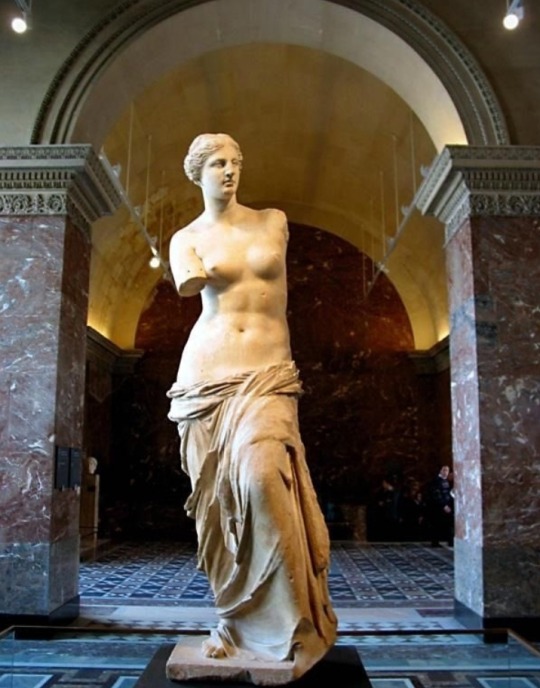
Venus de Milo — 2nd century BC
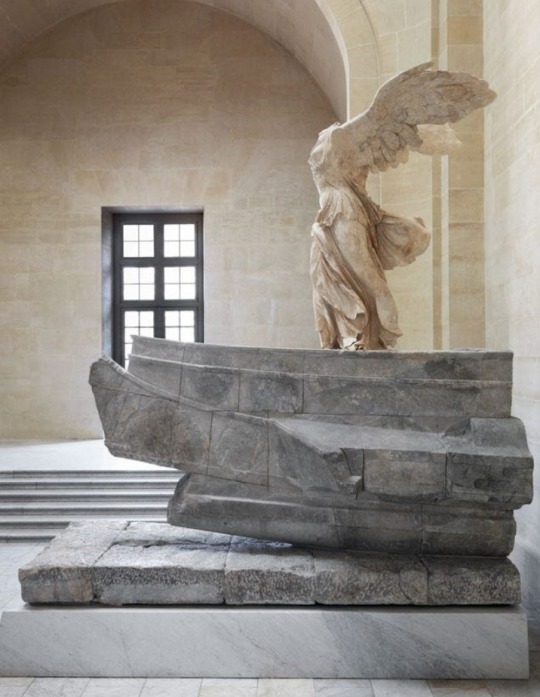
Winged Victory of Samothrace — 190 BC

Liberty Leading the People — 1830

The Raft of the Medusa — 1819

The Coronation of Napoleon — 1807

Psyche Revived by Cupid's Kiss — 1793

(L): The Seated Scribe — 2500 BC
(R): The Great Sphinx of Tanis — 2600 BC
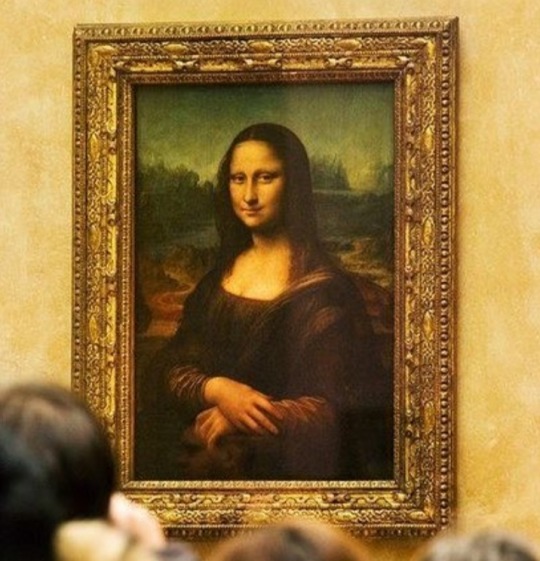
Mona Lisa — between 1503 and 1506
#The Louvre#Paris#France#museum#Code of Hammurabi#Venus de Milo#Winged Victory of Samothrace#Liberty Leading the People#Raft of the Medusa#Coronation of Napoleon#Psyche Revived by Cupid's Kiss#Seated Scribe#Great Sphinx of Tanis#Mona Lisa#artworks#history#today in history#ancient civilizations
10 notes
·
View notes
Note
C’est quoi la tirade du sphinx?
la tirade du SCRIBE* omg à aucun moment ça parle de sphinx j'ai juste fait un pet de cerveau, et sinon that's peak french cinema
youtube
28 notes
·
View notes
Text
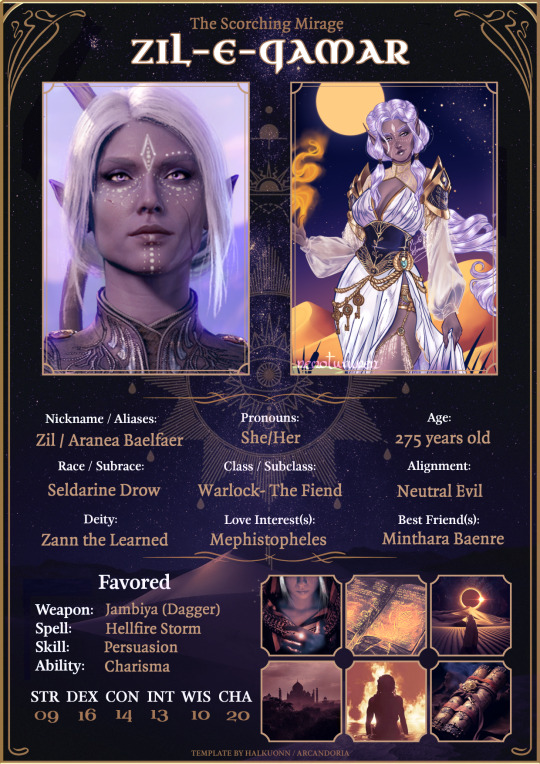
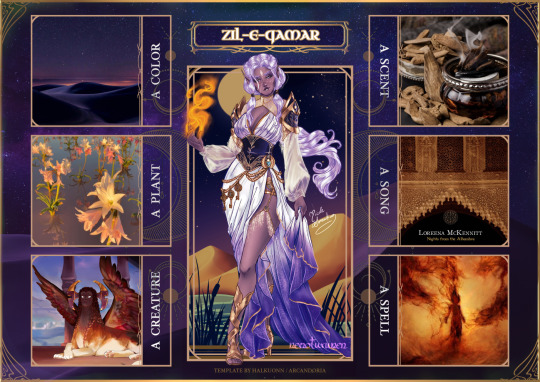

☪️ ZIL-E-QAMAR | FIEND WARLOCK | SELDARINE DROW ☪️
Name: Zil-e-Qamar
Nickname: Zil, Ya Qamar (only Halim called her so)
Title: The Scorching Mirage
Alias: Aranea Baelfaer
Age: ≅275 Years Old (She never disclosed her real age to anyone)
Birthplace: Menzoberranzan, Underdark Hometown: Huzuz, The City of Delight
Current Residence: She is wandering Faerun without a fixed place, collecting souls as she goes. When not on the Material Plane, she resides in Mephistar.
Alignment: Neutral Evil
Race: Seldarine Drow
Class: Warlock - The Fiend
Profession/job: Before the great tragedy that apprehended her life and forced her to flee to Faerun, she worked as a Scribe for the Grand Vizier Alyana al-Azzazi, a job she was immensely proud of. Visual particular traits: Standing at 183 cm barefoot, Zil is abnormally tall for a drow, and this is an anomaly for which she has no answer to give. Scent: Oud, Rose, Sandalwood, Saffron, Amber. Subsequently, sulfur and brimestone.
Colours/symbols associated with: The Colours of the Desert at Night; The White Heron that flew at dusk; The Sphinx whose riddles couldn’t be solved and whose smile couldn’t be understood.
Languages: Midani (mothertongue), Jaanti, Kadari, Infernal Language, Common Language, she is learning Undercommon.
Accent?: Before moving to Huzuz to embark on her studies at the Al-Bidr Sallah University, she spent her childhood and early teen years in Ajayib, the City of Wonders. Therefore, she spoke Midani with the regional accent of the Pearl Cities. Her accent translates even when she speaks the Common Language, immediately clocking her as not native of Faerun.
Tropes they embody: “Determinator”,” Implacable Woman”, “Deadpan Snarker”, “The Juggernaut”, “Broken Bird”, “Heartbroken Badass”, “Be Careful What You Wish For”, “Lady of Black Magic”, “Addicted to Magic”, “Dark Action Girl”, “Revenge Before Reason”, “The Dreaded”, ”Noble Demon”, ”Troubled Past”, “The Unfettered”, “Excessive Mourning”, “Long-Range Fighter”, “Love Makes you Evil,” “Roaring Rampage of Revenge”, “Squishy Wizard”, “Tragic Heroine”, “Tranquil Fury”, “Trauma Button”, “Violently Protective Girlfriend”, “Woobie, Destroyer of Worlds", "Cry for the Devil". Personality: Determinate, Curious, Mischievous, Resilient, Resourceful, Intuitive, Loyal toward those she loves, Secretive, Mysterious, Empathetic, Charming, Charismatic, Seductive, Ambitious, Prideful, Focused to the point of Obsession, Stubborn, Manipulative, Vengeful, Can become ruthless is pushed, Emotionally Withdrawn, Short-Tempered. Detailed Backstory: Zil-e-Qamar was the adopted daughter of Valakos and Breessa, a couple of Faerûnian tiefling merchants who permanently resided in Ajayib, the City of Wonders in the Land of Fate Zakhara. Zil had a childhood of relative comfort and ease, not wanting for anything. Ever a curious child, sometimes too nosy for her own good, she spent her childhood between school, helping her parents with trading and inventorying the goods they received from Faerûn, and exploring the caves upon which the city had been built. She was a brilliant young woman, with an incandescent personality and a silver tongue and cheeky personality that could easily charm the people around her. She wouldn't take “no” for an answer, especially when embarking on a quest to discover and learn about all manner of topics, though her interest always dwelled on Magic and all its different aspects and how they intertwined and connect.
Ajayib, despite being the cradle that sweetly protected her throughout her most tender years, had very little to offer to her ever-growing thirst for knowledge. Soon enough, she made preparations to move to the Capital of the Land of Fate, Golden Huzuz. After being admitted to the Home of the Seekers of Knowledge, the Great University of Al-Bidir Sallah in the City of Delight, she enrolled in the College of Magic to expand upon her knowledge and understanding of how magic worked. She was a hardworking student, with her nose always buried in any book she could put her hands on. It was around this time that she became a devotee of Zann the Learned, the God that oversaw Learning and Intelligence.
Eventually, under the advice of Imam Renn min Zann, her mentor at the University, she sought to learn more about who she was and where she stood in the world. She enrolled for a period in the College of Fine Arts, taking classes about non-Zakharan history and costumes in the hope of discovering more about her origins. After graduating and deciding to continue her studies as a scholar, she took up the position of Scribe for the Imam, and it was during that time that she met Halim Ibn Tariq, a well-renowned Sha'ir and Vizier of Huzuz, advisor to Grand Vizier Alyana al-Azzazi, in a diplomatic visit to the University to report of its state to the Grand Vizier.
Having been assigned to be the Vizier’s guide, Zil found herself intrigued by this physically imposing yet apparently kind and soft-spoken man, who had all the authority that was expected of a man of his station and background, yet possessed none of the arrogance, a man of exceptional moral strength and vivacious intelligence, known for his even temper and warm laughter.
On his side, Halim also found himself fascinated by the young drow, the first he ever had the chance to speak with in his life, with her pale eyes always twinkling with curiosity, her insatiable need for knowledge, and her mischievous way of flirting with him. He found her company pleasant and when away for his duties, he found himself unable to stop thinking about her and her beguiling, infectious smile. Despite their mutual interest, they both believed that, due to the Vizier’s busy life and Zil’s own duties, the few meetings they had at the University were destined to remain as such. Yet, Halim extended an invitation to her to seek him out if she ever needed anything, either a favour or even just his company. Little did Halim know about Zil’s own resilience and way of making things happen the way she wanted. Zil applied to become a Scribe in the service of Grand Vizier Al-Azzazi, to be closer to the man who had completely captivated her. She obtained the position, thanks to her own merits and partially thanks to the good recommendation of the Imam. In time, Zil and Halim became friends and started to spend more and more time together, their mutual attraction growing and blossoming like the beautiful lilies that bloomed in the pans surrounding Hazuz when the rains blessed the city. It grew until being far away from each other felt more torturous than standing underneath the ruthless Zakharan Sun at noon without shade.
With the blessing of the Grand Caliph himself, they married and spent more than 40 years of blissful happiness. But the Court of Enlightenment was not devoid of intrigue, and Halim, with his progressive philosophies and advocacy to abolish the common practice of trading slaves, had drawn upon itself the malcontent of the slave owners in the Caravan District. He had fallen victim to a ploy that resulted in an incrimination for corruption and bribery.
Zil knew that her husband was innocent, having worked closely with him for all those years, and tried with all the means she had available to find who was behind all that scheming and bring them to justice to clear her husband’s name. But before she could do anything of substance, she was apprehended and charged with the accusation of being complicit and accessory to all of Halim’s crimes. Despite all her efforts, despite all her begging, she couldn’t find the resources she needed fast enough, and the accusations against her husband transmuted from corruption to treason that warranted a death sentence without appeal.
All Zil could do was witness the execution from her cell, not leaving her husband’s eyes for one moment, not even when the blade of the executioner came down and shattered her entire heart in the process.
Alone in her damp cell, shell-shocked and broken, Zil waited all night for her own sentence to pass, wishing with all her might that the moment would come soon enough so that she could be reunited with her husband once more. But, much to her dismay, during the darkest hour that preceded the arrival of dawn, the Grand Vizier herself showed up in her cell, maintaining complete secrecy.
All she carried with her was a note, carved in her husband’s handwriting, and the promise that, as a last favor to Halim, she would see Zil out of Huzuz safely. Zil escaped her own death, thanks to her husband’s foresight and protection, and fled away from the Golden City and beyond Zakhara, finally reaching distant Faerûn.
After Halim’s death, Zil assumed a new name, Aranea Baelfaer, and turned to every god and goddess in the pantheon, begging, imploring, and beseeching all of them to grant her the power to vindicate her husband and to see him one last time. But all her prayers and supplications fell into a deafening silence that reeked of contempt. Enraged with the gods for letting something like this befall a man as virtuous, kind, and compassionate as her husband, she didn’t give up and persistently sought the means to gain the power she needed, her mind and resolve sharpened by grief and rage.
Her obsession and focus would reach such heights that they resonated all across the Weave until they attracted the Patron who would finally answer her call and grant her the power she desired: Mephistopheles. Most treasured possession: Her husband’s jambiya dagger and a lock of his dark hair that she wore braided in her own; the last letter that he wrote her, that she re-read every single night before going to sleep.
Sexual and/or romantic situation: After Halim’s death, she decided to forgo any kind of romantic relationship, absolutely refusing to run the risk of facing the same type of pain she went through when her husband was killed. In her grief, she asked Mephistopheles to actually freeze her heart, putting it in a stasis. As a wager between the two of them, Mephistopheles added a small clause that declared if someone were ever able to thaw her frozen heart, she would lose her powers, her soul would be his and the contract would be considered fulfilled regardless of whether she had reached her vengeance or not. Zil humored him, secure in her belief that no one on Toril would ever be able to ever ignite the flame in her dead heart again. Last famous words indeed. Favourite place in Faerûn: She doesn’t truly have one. She finds Faerun excessively cold and humid. But if she were to choose one, it would be the Great Harbor of Waterdeep, from where she can see the City. What makes them happiest: She likes to create small illusions of her memories of her years in Zakhara and stare at them, wishing with all her might that they were more than just echoes from a distant time. What makes them angriest: Any uncalled mentioning of her late husband was enough to provoke at best a death glare and at worst an outburst of pure ire. She didn’t appreciate talking about her past or about him with anyone, for her memories of him are hers and hers alone. What makes them laugh: She rarely laughed from the heart. But something that did make her laugh and gave her comfort was hearing children’s laughter. It reminded her of simpler times. Biggest secret: Who her Patron is and the terms and conditions of her pact with him. Obsession: Revenge. She sold her soul to Mephistopheles in order to gain the power she needed to grow as powerful as she needed to be and hunt down and kill whoever was involved in Halim’s betrayal and death. If the Gods didn’t want to help her in the path of vengeance, then the might of the Archdevils would.

soooo.
While on vacation, I had sometime to properly sit down and finally write Aranea's (or should I say Zil's?) proper bio, alongside working on her infographic (and I am SO HAPPY with how it turned out. I love doing this kind of things, I have done so many that I haven't shared lol).
I still need to add a few things as I keep playing the game, which is the reason why I haven't written anything about her current relationship with Gale, the other companions, or the Dream Guardian. But as I proceed, I will update this (or make another post, we shall see) and fill in what is missing.
In the meantime, thank you for reading her profile and I hope you will love this brainchild of mine just as much as I love her <3
--Nemo
-----------------------------------------------------------------------------------------
template by @arcandoria; abridged profile template by @lairofsentinel)
#baldur's gate 3#baldurs gate 3#bg3 tav#bg3#oc lore#dnd#dnd drow#drow#zakhara#OC:Aranea Baelfaer#my oc#my art#my writing#Nemo Draws#Nemo Writes
106 notes
·
View notes
Text
The Laughter of the Sphinx The laughter of the Sphinx caused my eyes to bleed The blood from my eyes flowed onto that ancient map of sand Ridiculous as I am often have I been drawn to such lands rippling oceans of silence and the distant, enigmatic glow of burning shops and burning scrolls overseen by river birds and mitered beasts sad-eyed scholars and mournful scribes omniscient ibises and in the dust-clogged air the laughter of the Sphinx endlessly riddling, endlessly echoing, loosing the blood’s engulfing tide
Michael Palmer, The Laughter of the Sphinx
3 notes
·
View notes
Text
NEPETA LEIJON NAMES + PRONOUNS + TITLES
(requested by no one, feel free to use anythin on here)
NAMES
•
ace/acey, ajax, alec, ally, aloise, archer, archie, ari/aria, asher, aspen, atlas, atticus, basil, beatrice, bennett, camille, carlotta, carter, casey, cecilia, chance, claudia, cordelia/delia, cordette, delilah, diana, dinah, emerald, esther, fang, felix, fern, flynn, forest/forrest, greta, jace, juliet, juniper, helena, kathleen, kestrel, kiki, knox, leo/leah/leona/leon, lev, levi, lola, lynn(ette), marca, marcy, marie/maria/marian, mars, matilda, matisse, mccoy, nala, nathalie, nebula, neptune, netuno, nia, niko, nina, noelle, nova, novella, nyx, oliver, ollie, onyx, opal, penelope, percy, perla, quill, rex, rudy, sage, savannah, spencer, tabitha, talon, tegan, thalia
•
PRONOUNS
•
*t/*ts, ?/?s, ac/acs, anon/anons, bea/beast/beasts/beastself, bell/bells, bite/bites, cat/cats, chomp/chomps, claw/claws, fel/feli/felis/feliself, fir/firs, fluff/fluffs, fur/furs, gi/grrs, gnaw/gnaws, h*/h*m, ki/kin, ki/kith, kit/kits, kne/knead/kneads, leo/leos, lynx/lynxs, mai/maine/maines/maineself, mew/mews, ne/nem/neir, ne/nym/nyr, nep/neps, non/nons, nya/nyans, pai/paints, paw/paws, pet/pets, pur/purs, purr/purrs, roa/roars, scratch/scratchs, sh*/h*r, she/fur/furs/furself, she/purr/purrs/purrself, she/sheer/sheers, shey/shem, shh/shhs, sphi/sphinx/sphinxs, tail/tails, tal/talon/talons/talonself, tea/teas, th*y/th*m, that one/that ones, that thing/that things, this one/this ones, tortie/torties, whisker/whiskers
•
TITLES
•
[PRN] with blood on [PRN]s paws, the olive scribe, kitty cat shipper cave [TERM], [PRN] with unwavering devotion, [PRN/TERM] of veridian blood, the heart hero, the rogue, [PRN] who stalks [PRN]s prey, the hunter/huntress, the thespian, the olive rogue, [PRN] with nine lives
•
#homestuck fictionkin#homestuck kin#hs fictionkin#hs kin#hskin#requests open#nepeta kin#nepeta leijon kin#npt pack#npt#npt list#npt ideas#npt suggestions#name recs#pronoun recs#homestuck kin help#kin help#hs kin help#kin help blog#endos dni#endos fuck off#endos are ableist#endos do not interact#trollkin#homestuck fictionfolk#kin tips#homestuck kin tips#fictionkin help#kin requests#species amplification
5 notes
·
View notes
Text
Almost everyone has seen this image of the Seated Scribe. Located on the upper floor of the Department of Egyptian Antiquities, this is the most famous of unknown figures. We know nothing about the person portrayed: neither his name, nor title, nor even the exact period during which he lived. Nevertheless, this statue never fails to impress visitors discovering it for the first time.

A specific posture
The Louvre's scribe, known as the "Seated Scribe", is indeed sitting cross-legged, his right leg crossed in front of his left. The white kilt, stretched over his knees, serves as a support. He is holding a partially rolled papyrus scroll in his left hand. His right hand must have held a brush, now missing. The most striking aspect of this sculpture is the face, particularly the elaborately inlaid eyes: they consist of a piece of red-veined white magnesite, in which a piece of slightly truncated rock crystal was placed. The front part of the crystal was carefully polished. The back side was covered with a layer of organic material, creating the color of the iris and also probably serving as an adhesive. The entire eye was then held in the socket by two large copper clips welded on the back. A line of black paint defines the eyebrows. The hands, fingers, and fingernails are sculpted with a remarkable delicacy. His chest is broad and the nipples are marked by two wooden dowels. The statue was cleaned in 1998, although the process merely reduced the wax overpainting. This restoration brought out the well-conserved ancient polychromy.
An unknown figure
The semicircular base on which the figure sits must have originally fit into a larger base that carried his name and titles, such as the base for the statue of Prince Setka, exhibited in room 22 of the Louvre. This base is missing, and the context of the discovery does not provide any additional information. According to the archeologist Auguste Mariette, who found the work, the statue of the scribe was apparently discovered in Saqqara on 19 November 1850, to the north of the Serapeum's line of sphinxes. But the precise location is not known; unfortunately, the documents concerning these excavations were published posthumously, the excavation journals had been lost, and the archives were scattered between France and Egypt. Furthermore, the site had been pillaged and ransacked, and no information concerning the figure's identity could be provided. Some historians have tried to link it to one of the owners of the statues discovered at the same time. The most convincing of these associates the scribe to Pehernefer. Certain stylistic criteria, such as the thin lips, which was unusual, the form of the torso, and the broad chest could support this theory. The statue of Pehernefer dates from the 4th Dynasty. This is an additional argument in favor of an earlier dating for this statue, which has sometimes been dated to the 6th Dynasty. Another argument supporting this date is that "writing" scribes were mostly created in the 4th and early 5th Dynasties; after this period, most scribes were portrayed in "reading" poses.
A scribe at work
The scribe is portrayed at work, which is unusual in Egyptian statuary. Although no king was ever portrayed in this pose, it seems that it was originally used for members of the royal family, such as the king's sons or grandsons, as was the case for the sons of Didufri (4th Dynasty), who were represented in this position.
#studyblr#history#art history#sculpture#ancient egyptian art#old kingdom#4th dynasty#5th dynasty#6th dynasty#egypt#ancient egypt#giza governorate#saqqara#auguste mariette#pehernefer#the seated scribe#limestone#papyrus
7 notes
·
View notes
Text
*A sphinx with the head of an older woman lounges sourrounded by bones *
Dimitra:Oh hello .I am Dimitra the sphinx .The scribe has requested I answer your questions.However I am *Licks lips* ravenous so be careful how many you ask
@ariel-seagull-wings @themousefromfantasyland @theancientvaleofsoulmaking @scarletblumburtonofeastlondon
9 notes
·
View notes
Note
So back in the 2000s Green Ronin Games published a D20 system Biblical RPG, called Testament. You could also call it bronze age historical fantasy, it's not just about playing as Hebrews there's also rules for Babylonians, Canaanites, and Egyptians. So there's classes like Desert Hermit, Idol-Maker, Khery-heb (egyptian scribe-wizards), Psalmist, Qedeshot (sacred prostitute) and Royal Astrologer
Anyway in this game Moses is a multiclass character as he's a 3rd-level Paladin/7th level Levite (effectively cleric)/10th-level Prophet (a prestige class)
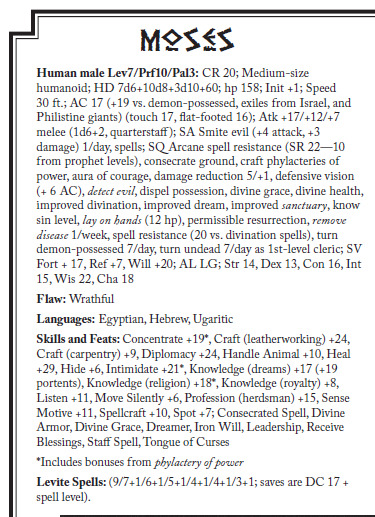
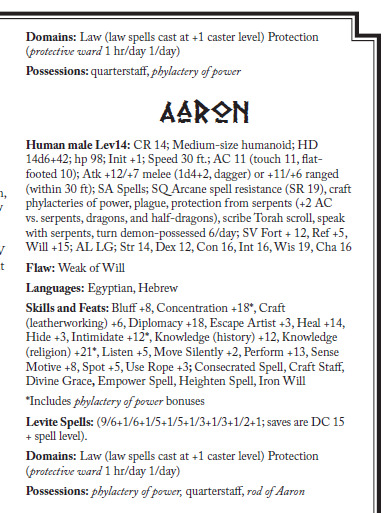
Joshua is a Paladin 10/Champion of Israel 4/Spy 2, Samson a Fighter 9/Champion of Israel 8/Judge 1 (so two prestige classes), David is Fighter 7/Psalmist 9 (basically bard)/Aristocrat 2/Rogue 2, Solomon Psalmist 10/Aristocrat 8, Elijah is a Levite 10/Prophet 9 and Elijah is a Commoner 2/Prophet 8
Jacob's a Levite 6/Prophet 7/Aristocrat 2, while Esau is a Ranger 9/Aristocrat 2
We know that Moses didn’t throw around cure spells in the Bible, his staff was not enchanted with a control water spell, he probably didn’t look a thing like Charleton Heston, and he likely didn’t race around in a chariot with Rameses before he became pharaoh; we aren’t claiming factual accuracy. Instead, we are striving to capture the spirit of the Bible. We’re trying to portray the general characteristics of the Biblical characters: Samson is really strong, Moses is a miracle-worker of incredible power, David is a poet as well as a warrior, and angels are great and terrifying creatures. We interpret the source material metaphorically. In other words, the Bible doesn’t tell us that Israelites physically battled tempter devils, or sphinxes, or other mythical monsters, or that seraphs transformed into fiery serpents (although there is etymological evidence to suggest that they could), but adding these features makes the game more playable.
Though I would point out that the bible does say Jacob physically battled an angel, which is why he was renamed Israel.
So, Moses is a cleric, Solomon is a wizard, Joshua is a paladin, David is a bard, Jesus is a sorcerer, his apostles and Paul are warlocks, Elisha is a druid, Elijah is a monk, Samson is a barbarian, Tahkemonite along with Eleazar and Dodo are fighters, John the Baptist is a ranger, Jacob is a rogue
I'm really cautious about using DnD terms to describe nuanced historical metaphysics like this. DnD's cosmology is a mess. I don't know how it works because the writers don't know how it works. It's very easy for readers to come away with the wrong impression, and tbh it often comes off with this corny-ass "hello fellow kids did you know the Buddha was literally a hecking druid" type energy.
I wanna stress: This is fun to think about, but please don't treat this as meaningful analysis of real-world religions. I wanna demonstrate how quickly these terms break down when you're looking at actual historical metaphysics.
If we wanted to analyze biblical characters with DnD terms, every Charismatic Jewish Holy Man would be classified as a warlock. Moses is not a nebulous intermediary between gods and mortals. The man famously had a covenant. The whole covenant thing is a pretty important part of Judaism. But then again, that brings up problems for what the destruction of the first temple would mean for the classification of Judaism. Does the development of the rabbinical system suddenly turn everyone from warlocks into clerics? Within Judaism, the word of God is the law under-girding the whole of the world, including nature. Does that make every Rabbi a druid?
Jesus certainly wouldn't be a sorcerer, hes just a God. His power isn't hereditary, he is literally God. Calling Christ a sorcerer would be heresy.
Solomon is a wizard. The DnD wizard archetype is quite literally based on the biblical character of Solomon.
Samson is kinda a paladin? I'm not entirely sure what he would be classified as.
The Apostles are tricky, because their classification would probably change as the doctrine developed. Initially they would probably be classified as warlocks who "inherited" the laws and works of the new covenant with God, which is warlock metaphysics. But, several of them were kinda in charge of writing the new laws of the covenant, which I guess would be cleric metaphysics. Several of them also have priestly vows, which is paladin metaphysics.
John the Baptist is the only one on this list who could be considered a DnD Druid. Baptism as a rite probably has non-jewish pre-christian roots. I guess its the closest thing Christian metaphysics has to "nature magic." But my even suggesting that the power of baptism stems from a source other than God would be heresy.
2K notes
·
View notes
Text
The Ministry of Tourism announces the artifacts that were chosen to be the featured pieces in December in antiquities museums across the country

The Ministry of Tourism conducted a public referendum through its pages on the social networking site Facebook, and the public chose this month a group of artifacts that highlight Egyptian civilization's interest in science, knowledge, and culture in celebration of Science Day, which falls on December 21 of each year. This date also coincides with the opening of Cairo University on the same day in 1908.
The most famous places chosen are the Museum of Islamic Art in Bab Al-Khalq and the Coptic Museum in Old Cairo because it displays a wooden board used to teach writing, carved on it numbers and writings in the ancient Coptic language. The choice also fell on the Al-Gaar Anderson Museum, which contains a metal ink container shaped like a fish. The Muhammad Ali Museum is also one of the most famous sites that were dedicated to spreading science in Egypt, and this museum displays three of the oldest inkwells in Egypt. You can also explore the Amhotep Museum in Saqqara, which displays a statue of the scribe Ptah Shepses, who held several titles, the most famous of which were judge and inspector of the god's priests.
If your flight arrives at Cairo International Airport, you should see the bronze statue of the god of wisdom, medicine, and writing, Thoth. If you are going to visit Alexandria, you should not miss visiting the Alexandria National Museum, which displays the First Class Order of Education. You can also visit the Greco-Roman Museum, which contains a marble statue depicting an intellectual wearing the Greek cloak "himation," which is a symbol of culture. You can visit all these places and more only with Egypt Tours, which will allow you to choose from many exciting tours.
If your ship will stop for some time in any of the Egyptian ports, choose one of Egypt Cruise Excursions, which is a priceless gift for any tourist visiting Egypt for the first time. You can find many tours available that are ideal options for exploring Egypt, such as Port Said Shore Excursions, which will enable you to visit all the famous archaeological sites. Sokhna Port receives millions of tourists every year, so we have organized many excursions from Sokhna Port so that you can choose the tour that suits your interests.
If your ship will only stop for a few hours in the port, you can book a half-day tour to Saqqara and the Dahshour Pyramids from Sokhna to enjoy a wonderful trip in a short time. Egypt is one of the most famous countries that has many amazing museums, so you should join the NMEC and Pyramids Tour from Sokhna Port, which will help you visit one of the most important and impressive museums in Egypt, which is the National Museum of Egyptian Civilization. You can visit many amazing archaeological sites in one tour if you book a Day tour to the Pyramids, Memphis, and Saqqara from Sokhna Port, which is one of the best-selling tours.
You can book Pyramids and Saqqara Desert Tours from Sokhna Port to enjoy exploring the Giza Pyramids and Saqqara area while riding four-wheel-drive bikes. If you are a fan of visiting amazing museums, just join our day tour to the museums in Cairo from Sokhna port to be able to visit the National Museum of Egyptian Civilization and Abdeen Palace. You can take your friends and family on an unforgettable trip by booking the Giza Pyramids and the Step Pyramid tour from Sokhna Port and taking many beautiful souvenir photos with the Giza Pyramids.
You can choose between watching the sunrise or sunset in the pyramids area during the quad bike at the Giza pyramids tour from Sokhna port, which will allow you to see a magical view that you will never forget throughout your life. You will be amazed by seeing the magnificent pyramids with the Sokhna Port to Cairo Pyramids day tour, and you will also be able to see the Sphinx.
@cairo-top-tours
0 notes
Text
Hello Egypt!
September 19, 2024
Today is our first full day in Egypt. Egypt is 4 times bigger than Michigan and has 108 million people as compared to Michigan’s 9 million. More land and a LOT more people. Cairo is the capital and has 23 million people more than twice the whole population of Michigan
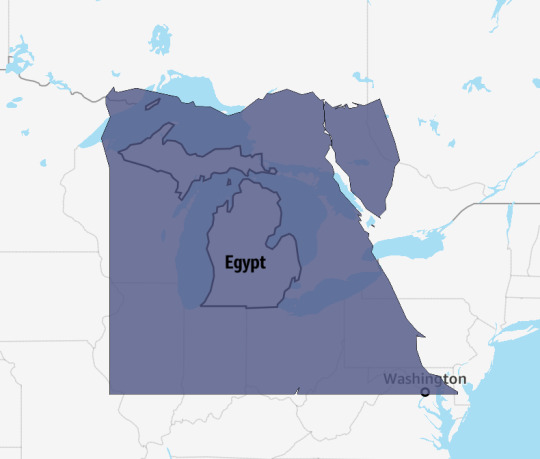
This morning we headed out to the Egyptian Museum built in 1902.
The Egyptian Museum in Cairo (EMC) is the oldest archaeological museum in the Middle East, housing over 170,000 artifacts. It has the largest collection of Pharaonic antiquities in the world.

Now we have been to the British Museum, The Field Museum in Chicago, The Detroit Institute of Arts, and The Boston Museum of Fine Arts (to name a few) and frankly I was surprised to see anything.
Our fine guide Ayman (pronounced Eye-man) took us on a little guided tour before he turned us loose. This in an old school museum and much of the artifacts are heading to the new and HUGE new Grand Egyptian Museum which is still not 100% open but maybe in a year or two. We will see the building tomorrow when we visit the Giza Pyramids and the Sphinx. OMG! I can’t wait.
But back to the prep. There are still some amazing artifacts left in this old museum including the treasures from King Tut’s tomb. But first…
Pharaoh Khufu: The builder of the Great Pyramid of Giza.

His only surviving statue is, ironically, the smallest piece of Egyptian royal sculpture ever discovered: a 7.5 cm (3 inch) high ivory statue found at Abydos. But there it is.
I particularly loved this sculpture of a scribe. Scribes were held in great regard - and when Ayman shown a light on his eyes the glass eyes became mesmerizing.
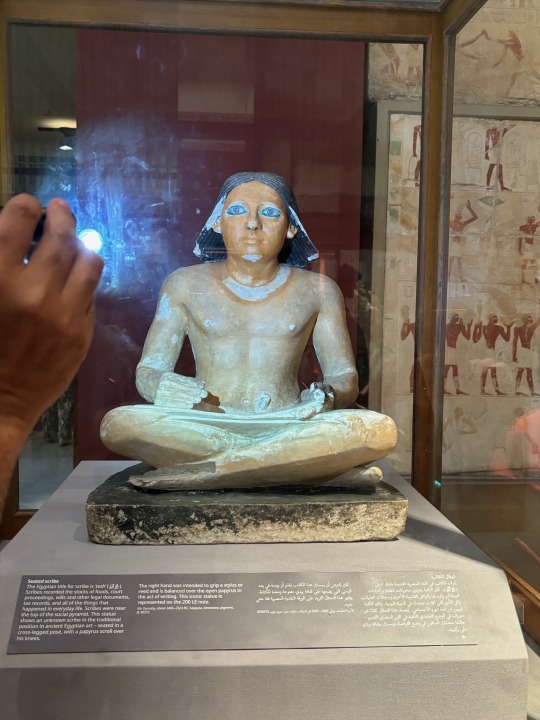
The ability to read and write was - and is - an amazing feat capable of changing lives.
Another story is that in 1974, the mummy of Ramesses II was in decline and need some expert help. Egypt appealed to specialists around the world and France stepped up. Ramesses II was being packed to be taken to France - when it was halted by paper work. NO ONE could visit France without a valid passport. CAN YOU BELIEVE THIS? Anyway - although this is not the best picture he had ever taken - the passport was indeed issued. He went to France and was stabilized. Below is the passport. Check out the birthdate.
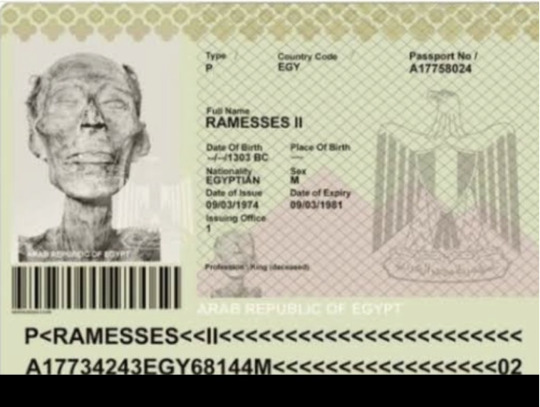
Amazing antiquities are at the place but who doesn’t love the King Tut stuff. Most of that cannot be photographed - so “hello” Internet. AWESOME!
But we did take these photos…
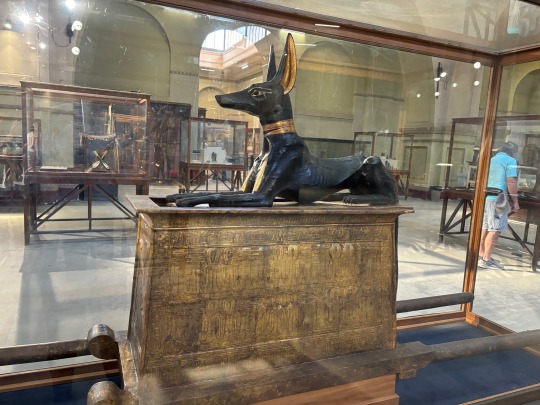


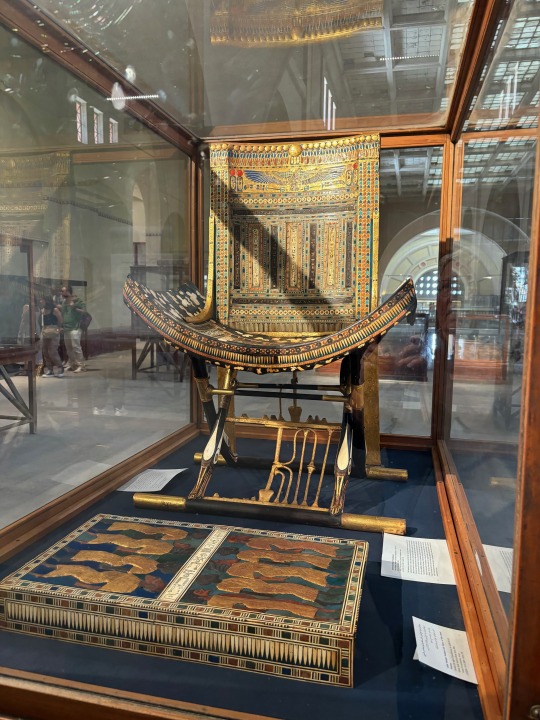
These photos are from the Internet - but we laid eyes on all of them.
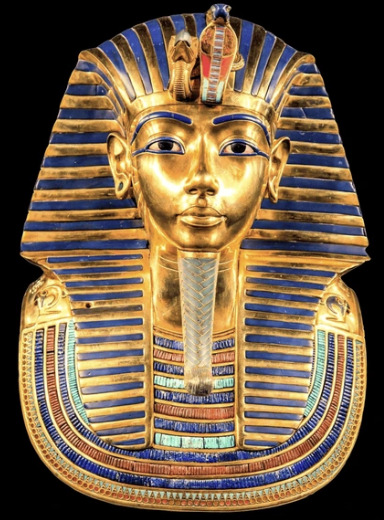
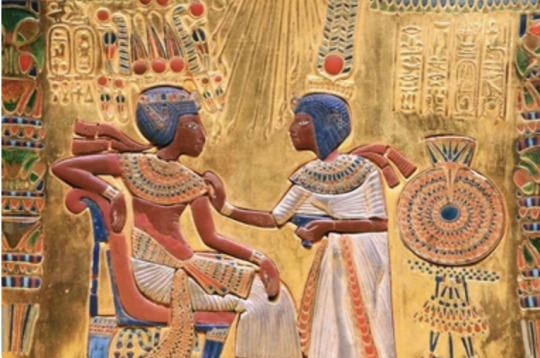
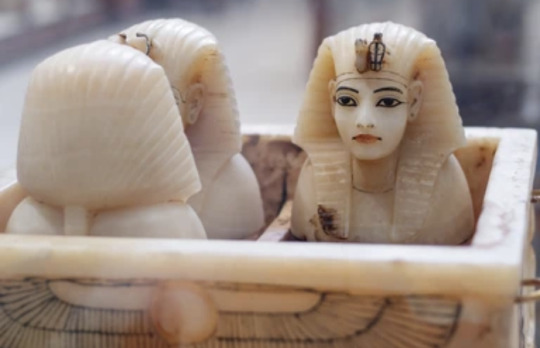
I truly enjoyed this Old School museum - and my proof that it is “OLD SCHOOL”


Read the last line. Cool - huh?
Tomorrow we will see some of the 111 pyramids of Egypt. That number is not a joke. 111.
Stay tuned.
1 note
·
View note
Text
The bronze sphinx statue, dating to the third century, was discovered in Dacia, a Roman province corresponding to modern-day Romania. The bronze sphinx statue bears several striking similarities to the famous Naxians’ Sphinx from 560 BCE.
Dacia is the ancient name for Romania and has seen the rule of various groups and empires throughout history. During ancient times, Dacia was part of the Dacian Kingdom before it was conquered by Rome.
It was determined that the inscription around the base of a bronze sphinx statue was written using the archaic Greek alphabet. However, the Greek alphabet phonetic values render a text that is non-sensical in the Greek language.
The words were written from left to right. The scribe was most likely attempting to express something in a language other than Greek by employing an archaic Greek alphabet. The phonetic values of the archaic Greek alphabet record a short rhythmic poem in Proto-Hungarian.
#history#archeology#archeologicalsite#sphinx#dacia#romanian#greek alphabet#language translation#decipher#inscription
1 note
·
View note
Text
Warning this is long, but it's worth it
After a hard journey working on the ship to pay for her trip and continue to hide her gender Jonna arrives in Oldtown where a Hightower soldier leaves her at the gates of the Citadel in front of the sphinxes guarding the entrance, from now on she must fend for herself.
Fortunately the enrollment at the Citadel to become a novice is surprisingly simple thanks to the fact that it is done at Scribe's Hearth where you are asked your name, your place of origin, how old you are supposed to be, if you have any basic knowledge and if you have anything with you.
Three hours after arriving in Oldtown Jonna is already a novice and no one has noticed that she is a girl.
No one except the one person who gives a second glance to the new "boy" from the North who has just been dropped off at the novice quarters. An equally newcomer named Alleras (who is absolutely not a girl whose real name is Sarella, how do you come up with such an absurd thought, wink, wink).
So notSarella decides to take the new boy "Jon" under her wing without revealing his true gender, but leaves subtle hints about how to disguise himself as a man for example by telling stories about how his sister disguised herself in such a way to look like a man or how a woman did something to try to get into the Citadel, this way "Jon" learns to look more masculine.
NotSarella kicks his partner out (puts something in his drink to make him sick and quarantined) so that "Jon" is in the same room as him.
In this way, notSarella gets a shadow and a partner in crime that he supports to make fun of the masters, thus making it possible for two women to study there.
Jonna planned to study medicine and language but when she sees all the subjects that can be studied as well as the huge library she stays longer as does not¡Sarella.
Eventually, possibly after Jonna’s blossom/flowering, Alleras reveals to Jonna that she is also a woman disguised as a man and their friendship grows stronger.
Sarella is possibly planning to put Jonna on House Martell's payroll by having Doran sponsor her, allowing her to have her own life in Essos but work as an informant and help when needed.
The fact that Jonna possibly has Dayne blood only further convinces Sarella that this is a good idea.
However, three years after Jonna arrives at the Citadel, Hugor Hightower, son of Baelor and grandson of Leyton, makes his appearance.
Newly knighted at the age of fifteen after helping defend Greyshield Island from pirate attack and winning a tournament in honor of his nephew, Lord Leyton Hightower's first great-grandson.(this is related to the family tree I am making)
Hugor is THE new golden bachelor of the Reach, (kicking Loras out of the position, Willas was kicked long ago) and one of the golden bachelors of Westeros in whom his grandfather shows that he trusts by delegating to him the position of Guardian of the Citadel so that he can demonstrate his abilities of management as future lord of Hightower and Oltown.
He also comes with Samwell Tarly under his arm and the occasional appearance of his Florent-eared uncle, Humfrey Hightower, who is the same age as him.
I am also going to add here all the subjects taught at the citadel:
The ones we already know:
-Ravenry
-Astronomy/Astrology
-History
-Mathematics and economics
-Warcraft
-Medicine, healing and the functions of the body
-Higher mysteries(magic)
Now the new ones (theorized) that will be included here: Thanks reddit for this.
-Herbalism
-Law
-Beasts of Land, Sea, and Sky (Animal Biology and Behavior)
-Dragons (Since the Conquest at very least)
-Equine Studies
-Masonry and Architecture
-Mechanics(pulleys and stuff)
-Agriculture and cattle raising
-Sailing and Seafaring
-Meteorology
-Geology
-Alchemy (Chemistry)
-Metallurgy
-Theology
This is for @catofadifferentcolor inspired by its amazing fem! jon snow bunnies which is a guilty pleasure of mine.
And I promised a fem! Jon x Hightower, so here I go.
I have three ideas of how the thing might go:
1.-Soulmark
2.-fem!Jon disguises herself as a man to study at the Citadel.
3.-Princess fem!jon desires freedom from the oppressive life in the Red Keep, knowing that her father will never allow her to travel North she heads South.
Commonalities of all ideas:
fem!jon name is Jonna(this may change).
All ideas start before canon.
The name of fem!jon's couple is Hugor Hightower and Sam is his "squire" more like Hugor's right hand man.
Friendship between Jonna and Satin, Sam as well as Alleras.
Exploration of the faith of the Seven.
The Hightowers seeking information of magic and omens about the White Walkers.
The dragon eggs of Jonna and her future children are from Silverwind and the eggs come from the Red Lake where the dragon made her lair at the end of the Dance of the Dragons.(That is unless Cannibal makes an appearance).
I explain the three ideas here below:
1.- Soul Marks
The Old and New Gods decide to unite Jonna Snow the bastard of Lord Eddard Stark with Hugor Hightower, grandson of the current lord of House Hightower, Lord Leyton Hightower.
This one is very much inspired by Bequeathed from Pale Estates by Author376 which is possibly the best fem!jon fic ever written.
But I feel like anything I would write would be a bad copy and so I'm not too excited about this one.
From the beginning it's all about the Hightower's looking for hints of the others.
Jonna is forced to bear the heavy burden of how to manage a house like the Hightowers(luckily she has help) as she is the future mistress of this house as well as adapting to the south, its customs and religion one that she has always shunned as that was her stepmother's domain.(This however helps her prepare for when she is queen).
Bran travels with Jonna to the south as Hugor's squire, the rest of the Starks stay in the North at least at first.
(This one is undecided)Shireen joins the traveling party at Dragonstone because it is believed that a cure has been found at the Citadel or at least they are close to finding it. Patchface soon dies.
The traveling party goes by ship and accidentally attend Daenerys' wedding with Khal Drogo. Hugor murders Jorah at the wedding to cleanse the honor of the North and the Hightower (Shireen poses as a Florent if she goes with them on the voyage).
Brienne becomes Shireen's handmaiden. So that she has a protector in places where the men cannot go.
Lots of exploration of the Faith of the Seven.
Tyrell and Hightower being family and acting like it. Jonna realizing that the Starks and the Tyrells are more alike than she will ever admit.
Olenna thinks Jonna looks like the Targaryens and dismisses that thought immediately as absurd and that her eyesight is failing. It doesn't take well to realize that she figured it out before anyone else and can't rub it in the others' faces.
Prophecy of Azor Ahai reimagined using the old gods and the faith of the Seven as drivers and a bit of Valyrian sacrifices.
Good Aegon/young Griff. I'm not sure about Daenerys.
Jonna and Hugor have two children before the war against the Others the rest come after.
For now that's what I have for this idea.
------
2.- fem!Jon disguises herself as a man to study at the Citadel.
Jonna calls herself Jon. She left Winterfell because she felt there would be no future for her if she always stayed under the protection of her father and Robb.
She studies medicine and languages mostly to be able to go to Essos someday and make money there.
Together with Sam and Alleras she discovers the cure for the greyscales.
She stays away from Hugor as she fears he will discover her secret and cast her out. However they are not able to stay away for long almost as if fate or a certain raven manipulated destiny to bring them together.
Many think that Jonna is Lord Dayne's bastard son whom he does not want around so that he does not threaten the status of his son Edric.
Exploration of the Citadel.
Road trip throughout Westeros in search of omens about the Others by mandate of Lord Leyton Hightower. A certain person may birth dragons during the course of this or encounter Cannibal.
Prophecy of Azor Ahai reimagined using the Old Gods and the faith of the Seven as drivers and a bit of Valyrian sacrifices.
Well Aegon/young Griff. Not sure about Daenerys.
----
Princess fem!jon desires freedom from the oppressive life in the Red Keep, knowing that her father will never allow her to travel north she heads south.
Targaryen Drama
Nobody expects Cannibal
The moment Jonna leaves the capital things start to get crazy, thank goodness she got out of there.
It's basically Jonna and Hugor having their slow romance while King's Landing is in flames.
#asoiaf#a song of ice and fire#female jon snow#house hightower#game of thrones#fic ideas#baelor hightower#sarella sand#alleras the sphinx#got#jon snow x oc
61 notes
·
View notes
Photo


Rutene Merk / Issy Wood
4 notes
·
View notes
Photo

Here’s the same scribe we find on the back of 200 #Egyptian LE. Wherever sphere of ancient Egyptian activity we examine - on the farms, in the workshops, in army units, temple offices or departments of state - we invariably bump into the ubiquitous #scribe, the sesh. He belonged to a well-defined and rather exclusive caste, standing out from the surrounding illiteracy by his command of the secret skills of reading and writing. These qualifications were considered a privilege, and perhaps a #mystery, shared only with the rulers and the gods. 👍 Follow me for more! @Anyextee Tag someone you'd take to Egypt with you ! Double tap if you love this! ❤️❤️ Turn On Post Notifications 😍 If you're planning to visit Egypt contact me to know more informations about my tours. Save it for your next trip in Egypt 🇪🇬 Don't forget to: ❤️ Like 🎤 Comment 👥 Share ✅ Save #pyramids #sphinx #giza #pyramidsofgiza #history #esoteric #sesh #sacred #scaredspace #holyodholies #edfu # #historical #picoftheday #travel #history #historical #tourism #ancient #egyptiancivilization #egyptology #egyptianart #anyextee #adeptexpeditions (at Cairo, Egypt) https://www.instagram.com/p/CjvGbC7LGbe/?igshid=NGJjMDIxMWI=
#egyptian#scribe#mystery#pyramids#sphinx#giza#pyramidsofgiza#history#esoteric#sesh#sacred#scaredspace#holyodholies#edfu#historical#picoftheday#travel#tourism#ancient#egyptiancivilization#egyptology#egyptianart#anyextee#adeptexpeditions
0 notes
Text
Rouka Reads: The World of Ice and Fire - Preface
We meet our hero, the brave author of the book, maester Yandel!
Let’s begin with some nice The Builder metaphors on the subject of learning!
IT IS SAID with truth that every building is constructed stone by stone, and the same may be said of knowledge, extracted and compiled by many learned men, each of whom builds upon the works of those who preceded him. What one of them does not know is known to another, and little remains truly unknown if one seeks far enough. Now I, Maester Yandel, take my turn as mason, carving what I know to place one more stone in the great bastion of knowledge that has been built over the centuries both within and without the confines of the Citadel—a bastion raised by countless hands that came before, and which will, no doubt, continue to rise with the aid of countless hands yet to come.
I like him. I mean, he may just be good with words, but I like the community aspect he is leaning into here.
Pro: The accumulation of knowledge is most definitely teamwork through the passage of time, and you can live many lives and travel vast distances in your mind through the power of the written word.
Con: If you’re going to be writing a book about the entire world, you may want to have seen at least a little of it, maybe? Yandel trying to make sure he is as unbiased as possible by making sure he knows equally little about Westeros through his own experience as he knows about Essos and the rest of the known world.
Because he has literally never left Oldtown and spent his entire life in the Citadel from birth.
I was a foundling from my birth in the tenth year of the reign of the last Targaryen king, left on a morning in an empty stall in the Scribe’s Hearth, where acolytes practiced the art of letters for those who had need.
That would have been around 272, ten years after Jaehaerys II died, thirteen years after Summerhall and the birth of one Rhaegar Targaryen. Yandel isn’t even thirty yet. He’s a baby!
The Scribe’s Hearth:
The gates of the Citadel were flanked by a pair of towering green sphinxes with the bodies of lions, the wings of eagles, and the tails of serpents. One had a man's face, one a woman's. Just beyond stood Scribe's Hearth, where Oldtowners came in search of acolytes to write their wills and read their letters. Half a dozen bored scribes sat in open stalls, waiting for some custom. At other stalls books were being bought and sold.
(AFFC, Samwell V)
I wonder who placed him there. A spot frequented by acolytes, the same demographic known to prance about Oldtown, getting drunk on fearsomely strong cider and visiting brothels if they have the money. Could a woman have just walked in there with a baby in her arms and left without it during early business hours, hidden among the people perusing the wares? Or was it a man? An acolyte familiar with the place? The father?
Actually that was about the year Obara was born, too. Wild times in Oldtown, but a nicer fate for Yandel.
The course of my life was set that day, when I was found by an acolyte who took me to the Seneschal of that year, Archmaester Edgerran. Edgerran, whose ring and rod and mask were silver, looked upon my squalling face and announced that I might prove of use. When first told this as a boy, I took it to mean he foresaw my destiny as a maester; only much later did I come to learn from Archmaester Ebrose that Edgerran was writing a treatise on the swaddling of infants and wished to test certain theories.
I love this.
Yandel: Did he sense my destiny??
Edgerran: Free infant test subject, and I didn’t even have to be unethical about it! Score!
(Silver represents medicine.)
Ebrose is still around, giving lectures on urine to the Oldtown gang and giving Pate a failing grade!
But inauspicious as that may seem, the result was that I was given to the care of servants and received the occasional attention of maesters. I was raised as a servant myself amongst the halls and chambers and libraries, but I was given the gift of letters by Archmaester Walgrave.
Awww. Hi, Walgrave! Good to know he was nice to kids back when his mind was still 100%. I wonder what prompted him to teach the kid to read. Was Yandel a bit of a beloved mascot, having been raised at the Citadel?
Thus did I come to know and love the Citadel and the knights of the mind** who guarded its precious wisdom. I desired nothing more than to become one of them—to read of far places and long-dead men, to gaze at the stars and measure the passing of the seasons.
Rarely do characters in this series fulfill their dreams so easily.
Also interesting that the kid raised among “knights guarding wisdom” (from whom?) in a complex named for defensive fortifications, who probably rarely spent time outside it, is writing a book primarily aimed at the “humble”. Trying to smuggle that wisdom out, in a way.
** Luwin shout-out:
"There are some who call my order the knights of the mind," Luwin replied. "You are a surpassing clever boy when you work at it, Bran. Have you ever thought that you might wear a maester's chain? There is no limit to what you might learn." (AGOT, Bran IV)
Bran was not interested, but he ends up assembling vital historical knowledge nevertheless.
And so I did. I forged the first link in my chain at three-and-ten, and other links followed. I completed my chain and took my oaths in the ninth year of the reign of King Robert, the First of His Name, and found myself blessed to continue at the Citadel, to serve the archmaesters and aid them in all that they did.
What a nerd! At thirteen! That would have been in 285, two years into Robert’s reign, and it took him seven years until 292 to finish his degree forge his chain. He was 20 then.
They did not send this little low-born prodigy out to serve at any castle, they kept him at the Citadel. Interesting.
So basically, watching Robert Baratheon’s reign has been Yandel’s thing for the duration of his academic career and he dedicated his Big Book to him his son Tommen:

I wonder what his purpose with this book is.
It was a great honor, but my greatest desire was to create a work of mine own, a work that humble but lettered men might read—and read to their wives and children—so that they would learn of things both good and wicked, just and unjust, great and small, and grow wiser as I had grown wiser amidst the learning of the Citadel.
He’s writing a book for humble but lettered men - and their families. Going on the assumption he is not trying to insult highborn men without a Citadel education by implying they are intellectually humble, he may truly intend for this book to be read by a wider audience than merely those who have access to maester’s libraries, an audience who conduct their own education by reading amid their family? Lower nobility or even the wealthy merchant class? Not sure how feasible this is in a world without a movable type printing press, but I like his approach.
And so I set myself to work once more at my forge, to make new and notable matter around the masterworks of the long-dead maesters who came before me. What follows herein sprang from that desire: a history of deeds gallant and wicked, peoples familiar and strange, and lands near and far.
Likening himself to the Smith, the face of the Seven most associated with the smallfolk.
Comrade Yandel, you have my ear.
Next up: The Dawn Age
32 notes
·
View notes